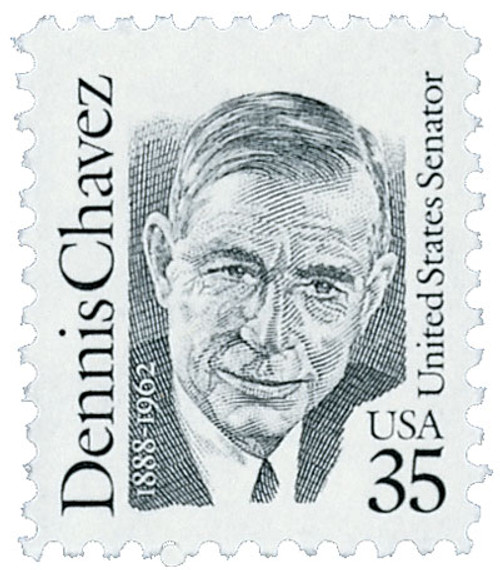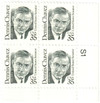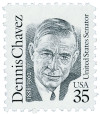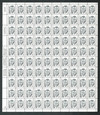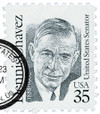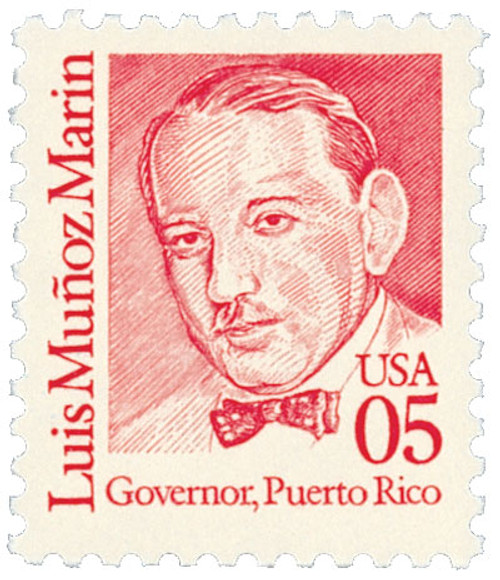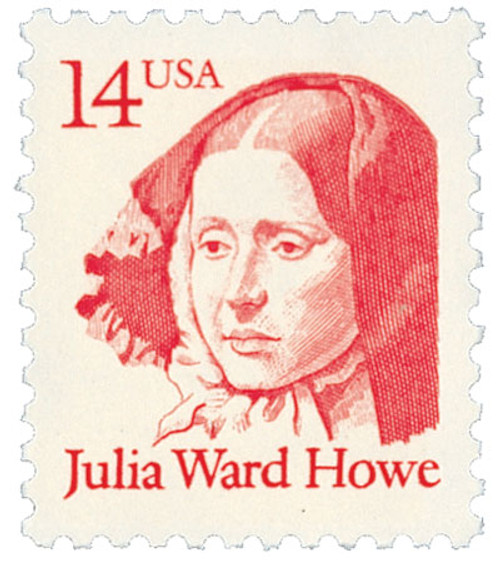
# 2186 - 1991 35c Great Americans: Dennis Chavez
U.S. #2186
1991 35¢ Dennis Chavez
Great Americans
- First Great Americans stamp printed outside the BEP
- First privately-printed intaglio stamp since the Overrun Countries of 1943-44
- First US stamp printed outside the country (Canada) – led to Congressional inquiry
- 49th stamp in Great Americans Series, second in series to honor person of Hispanic descent
Stamp Category: Definitive
Series: Great Americans
Value: 35¢, the half-ounce rate to Mexico
First Day of Issue: April 3, 1991
First Day City: Albuquerque, New Mexico
Quantity Issued: 480,000,000
Printed by: Canadian Bank Note Company for Stamp Venturers
Printing Method: Engraved
Format: Panes of 100 in sheets of 600
Perforations: 10.9
Color: Black
Why the stamp was issued: To pay the half-ounce rate to Mexico that took effect on February 3, 1991. Chavez’s daughters had been campaigning for a stamp honoring their father for many years. They initially hoped for a stamp in 1988 to mark his 100th birthday and eventually gained several influential supporters that helped the stamp get made.
About the stamp design: Chavez’s family requested that the stamp be based on a painting of the senator that hung in the New Mexico state capitol in Santa Fe. The capitol was under renovation at the time and the painting was stored away. So artist Christopher Calle based his pencil sketches on photos of the painting, with some reference to other photos to be sure he captured Chavez’s likeness accurately.
First Day City: The First Day ceremony for this stamp was held at the Center for Southwest Research in the Zimmerman Library of the University of New Mexico in Albuquerque.
Unusual fact about this stamp: News of the stamp’s printing outside of America set off a firestorm of criticism and debate that made it all the way to Congress. The stamp was announced a year earlier in February 1990. At that time, the denomination was unknown as new rates were expected in 1991. By 1991, the denomination was set at 35¢, which was the rate for a half-ounce letter to Mexico.
The expected rate change came on February 3, and the Chavez stamp was announced for issue on April 3. A USPS news release mistakenly stated the stamp was printed by the Bureau of Engraving and Printing (BEP). However, it was actually printed by the Canadian Bank Note Company, a subcontractor of Stamp Venturers of Fairfax, Virginia. Because of the rate increase, there was an increased demand for new stamps and the USPS believed the BEP would be too overloaded to print them all. Making contracts with private companies wasn’t new, but that company being outside of the US – in Canada – was. The USPS claimed that there weren’t many American companies that offered the intaglio printing process they had used on all the previous Great Americans stamps.
The USPS stated that the arrangement didn’t violate the “Buy America” Act, which required government agencies to use American-made products as much as possible. According to the USPS, more than two-thirds of the work on the Chavez stamp would be done in the US. It was printed on American-made paper and after printing in Ottawa, would be perforated back in the US.
Despite these assurances, the USPS faced immediate backlash. Linn’s issued a highly critical editorial calling it a “shameful spectacle,” and that it was “outraged” at the “colossal embarrassment.” Linn’s went on to say, “One of the philatelic hallmarks of colonies and second-class nations has been that they have foreign firms print their stamps.” While there were many that sided with Linn’s, there were some that supported the idea. They believed the stamp (and others produced outside the US) had beautifully detailed engraving. And they claimed opposition to the stamp was “isolationist” and “economic protectionist.”
Many others weighed in – including the House Committee on Post Office and Civil Service, who had serious concerns, stating “That a ‘Great Americans’ series stamp should be printed outside the United States is particularly disturbing… If legislation is necessary to ensure that future printing is done domestically, we will work with you to develop that legislation.”
The postmaster general ultimately heard these calls and announced that no more stamps (after the 1992 Earl Warren stamp already in production) would be printed outside of the US.
About the Great Americans Series: The Great Americans Series was created to replace the Americana Series. The new series would be characterized by a standard definitive size, simple design, and monochromatic colors.
This simple design included a portrait, “USA,” the denomination, the person’s name, and in some cases, their occupation or reason for recognition. The first stamp in the new series was issued on December 27, 1980. It honored Sequoyah and fulfilled the new international postcard rate that would go into effect in January 1981.
The Great Americans Series would honor a wider range of people than the previous Prominent Americans and Liberty Series. While those series mainly honored presidents and politicians, the Great Americans Series featured people from many fields and ethnicities. They were individuals who were leaders in education, the military, literature, the arts, and human and civil rights. Plus, while the previous series only honored a few women, the Great Americans featured 15 women. This was also the first definitive series to honor Native Americans, with five stamps.
The Bureau of Engraving and Printing (BEP) produced most of the stamps, but private firms printed some. Several stamps saw multiple printings. The result was many different varieties, with tagging being the key to understanding them. Though there were also differences in perforations, gum, paper, and ink color.
The final stamp in the series was issued on July 17, 1999, honoring Justin S. Morrill. Spanning 20 years, the Great Americans was the longest-running US definitive series. It was also the largest series of face-different stamps, with a total of 63.
Click here for all the individual stamps and click here for the complete series.
History the stamp represents: The first American-born Hispanic senator, Dionisio “Dennis” Chávez was born on April 8, 1888, in Los Chaves, New Mexico.
Chávez’s family had lived in Los Chaves for generations. In fact, he always prided himself in saying he was “American before Plymouth Rock,” because he had ancestors that lived in the New World on a Spanish land grant in the 17th century.
In 1895, Chávez’s father moved the family to Albuquerque for railroad work. Chávez attended school there until the 7th grade when he needed to take a job to help out the family. His first job was driving a grocery wagon at the age of 13. However, Chávez continued to learn by spending his evenings at the Albuquerque Public Library studying engineering as well as American history and politics. Chávez was eventually fired from his job at the grocery store for refusing to deliver groceries to strike breakers.
Meanwhile, Chávez used his new knowledge of engineering to get a job as a surveyor and eventually assistant to the Albuquerque city engineer. Chávez’s work earned him the attention of Senator Andrieus A. Jones, who hired him as a Spanish interpreter in 1916. After Jones won the election, Chávez moved to Washington, D.C. to work on his staff. Jones then encouraged Chávez to attend Georgetown University Law School.
After graduating in 1920, Chávez moved back to Albuquerque where he opened a law practice and joined local politics. Two years later, he was elected to the state House of Representatives, where he supported legislation offering free text books to school children. In 1930, he was elected to the US House of Representatives. In that role, he supported the Elephant Butte Dam and Carlsbad Irrigation Projects, as well as compensation to New Mexico Pueblo Indians.
Chávez joined the Senate in 1935 to fill a vacancy and then easily won election to that office the next year. For the next 27 years, Chávez used his position to promote the development of resources in the West, including water and soil conservation programs, federal crop insurance, and rural electrification. He also introduced several bills aimed at protecting Native American lands and rights.
On the national stage, Chávez supported America’s involvement in NATO (North Atlantic Treaty Organization), helped create America’s Good Neighbor Policy with Latin America, and helped develop the Pan American highway. Chávez also co-sponsored the Fair Employment Practices Commission Bill, which would prohibit discrimination in employment. However, these rights wouldn’t be won until the 1964 Civil Rights Bill that was passed two years after his death.
Chávez died on November 18, 1962, in Washington, D.C. President Lyndon B. Johnson delivered his eulogy, stating that, “Chávez was a man who recognized that there must be champions for the least among us.” In 1966, a statue of Chávez was added to the Capitol building’s Statuary Hall, the only such statue there to honor a New Mexican.
U.S. #2186
1991 35¢ Dennis Chavez
Great Americans
- First Great Americans stamp printed outside the BEP
- First privately-printed intaglio stamp since the Overrun Countries of 1943-44
- First US stamp printed outside the country (Canada) – led to Congressional inquiry
- 49th stamp in Great Americans Series, second in series to honor person of Hispanic descent
Stamp Category: Definitive
Series: Great Americans
Value: 35¢, the half-ounce rate to Mexico
First Day of Issue: April 3, 1991
First Day City: Albuquerque, New Mexico
Quantity Issued: 480,000,000
Printed by: Canadian Bank Note Company for Stamp Venturers
Printing Method: Engraved
Format: Panes of 100 in sheets of 600
Perforations: 10.9
Color: Black
Why the stamp was issued: To pay the half-ounce rate to Mexico that took effect on February 3, 1991. Chavez’s daughters had been campaigning for a stamp honoring their father for many years. They initially hoped for a stamp in 1988 to mark his 100th birthday and eventually gained several influential supporters that helped the stamp get made.
About the stamp design: Chavez’s family requested that the stamp be based on a painting of the senator that hung in the New Mexico state capitol in Santa Fe. The capitol was under renovation at the time and the painting was stored away. So artist Christopher Calle based his pencil sketches on photos of the painting, with some reference to other photos to be sure he captured Chavez’s likeness accurately.
First Day City: The First Day ceremony for this stamp was held at the Center for Southwest Research in the Zimmerman Library of the University of New Mexico in Albuquerque.
Unusual fact about this stamp: News of the stamp’s printing outside of America set off a firestorm of criticism and debate that made it all the way to Congress. The stamp was announced a year earlier in February 1990. At that time, the denomination was unknown as new rates were expected in 1991. By 1991, the denomination was set at 35¢, which was the rate for a half-ounce letter to Mexico.
The expected rate change came on February 3, and the Chavez stamp was announced for issue on April 3. A USPS news release mistakenly stated the stamp was printed by the Bureau of Engraving and Printing (BEP). However, it was actually printed by the Canadian Bank Note Company, a subcontractor of Stamp Venturers of Fairfax, Virginia. Because of the rate increase, there was an increased demand for new stamps and the USPS believed the BEP would be too overloaded to print them all. Making contracts with private companies wasn’t new, but that company being outside of the US – in Canada – was. The USPS claimed that there weren’t many American companies that offered the intaglio printing process they had used on all the previous Great Americans stamps.
The USPS stated that the arrangement didn’t violate the “Buy America” Act, which required government agencies to use American-made products as much as possible. According to the USPS, more than two-thirds of the work on the Chavez stamp would be done in the US. It was printed on American-made paper and after printing in Ottawa, would be perforated back in the US.
Despite these assurances, the USPS faced immediate backlash. Linn’s issued a highly critical editorial calling it a “shameful spectacle,” and that it was “outraged” at the “colossal embarrassment.” Linn’s went on to say, “One of the philatelic hallmarks of colonies and second-class nations has been that they have foreign firms print their stamps.” While there were many that sided with Linn’s, there were some that supported the idea. They believed the stamp (and others produced outside the US) had beautifully detailed engraving. And they claimed opposition to the stamp was “isolationist” and “economic protectionist.”
Many others weighed in – including the House Committee on Post Office and Civil Service, who had serious concerns, stating “That a ‘Great Americans’ series stamp should be printed outside the United States is particularly disturbing… If legislation is necessary to ensure that future printing is done domestically, we will work with you to develop that legislation.”
The postmaster general ultimately heard these calls and announced that no more stamps (after the 1992 Earl Warren stamp already in production) would be printed outside of the US.
About the Great Americans Series: The Great Americans Series was created to replace the Americana Series. The new series would be characterized by a standard definitive size, simple design, and monochromatic colors.
This simple design included a portrait, “USA,” the denomination, the person’s name, and in some cases, their occupation or reason for recognition. The first stamp in the new series was issued on December 27, 1980. It honored Sequoyah and fulfilled the new international postcard rate that would go into effect in January 1981.
The Great Americans Series would honor a wider range of people than the previous Prominent Americans and Liberty Series. While those series mainly honored presidents and politicians, the Great Americans Series featured people from many fields and ethnicities. They were individuals who were leaders in education, the military, literature, the arts, and human and civil rights. Plus, while the previous series only honored a few women, the Great Americans featured 15 women. This was also the first definitive series to honor Native Americans, with five stamps.
The Bureau of Engraving and Printing (BEP) produced most of the stamps, but private firms printed some. Several stamps saw multiple printings. The result was many different varieties, with tagging being the key to understanding them. Though there were also differences in perforations, gum, paper, and ink color.
The final stamp in the series was issued on July 17, 1999, honoring Justin S. Morrill. Spanning 20 years, the Great Americans was the longest-running US definitive series. It was also the largest series of face-different stamps, with a total of 63.
Click here for all the individual stamps and click here for the complete series.
History the stamp represents: The first American-born Hispanic senator, Dionisio “Dennis” Chávez was born on April 8, 1888, in Los Chaves, New Mexico.
Chávez’s family had lived in Los Chaves for generations. In fact, he always prided himself in saying he was “American before Plymouth Rock,” because he had ancestors that lived in the New World on a Spanish land grant in the 17th century.
In 1895, Chávez’s father moved the family to Albuquerque for railroad work. Chávez attended school there until the 7th grade when he needed to take a job to help out the family. His first job was driving a grocery wagon at the age of 13. However, Chávez continued to learn by spending his evenings at the Albuquerque Public Library studying engineering as well as American history and politics. Chávez was eventually fired from his job at the grocery store for refusing to deliver groceries to strike breakers.
Meanwhile, Chávez used his new knowledge of engineering to get a job as a surveyor and eventually assistant to the Albuquerque city engineer. Chávez’s work earned him the attention of Senator Andrieus A. Jones, who hired him as a Spanish interpreter in 1916. After Jones won the election, Chávez moved to Washington, D.C. to work on his staff. Jones then encouraged Chávez to attend Georgetown University Law School.
After graduating in 1920, Chávez moved back to Albuquerque where he opened a law practice and joined local politics. Two years later, he was elected to the state House of Representatives, where he supported legislation offering free text books to school children. In 1930, he was elected to the US House of Representatives. In that role, he supported the Elephant Butte Dam and Carlsbad Irrigation Projects, as well as compensation to New Mexico Pueblo Indians.
Chávez joined the Senate in 1935 to fill a vacancy and then easily won election to that office the next year. For the next 27 years, Chávez used his position to promote the development of resources in the West, including water and soil conservation programs, federal crop insurance, and rural electrification. He also introduced several bills aimed at protecting Native American lands and rights.
On the national stage, Chávez supported America’s involvement in NATO (North Atlantic Treaty Organization), helped create America’s Good Neighbor Policy with Latin America, and helped develop the Pan American highway. Chávez also co-sponsored the Fair Employment Practices Commission Bill, which would prohibit discrimination in employment. However, these rights wouldn’t be won until the 1964 Civil Rights Bill that was passed two years after his death.
Chávez died on November 18, 1962, in Washington, D.C. President Lyndon B. Johnson delivered his eulogy, stating that, “Chávez was a man who recognized that there must be champions for the least among us.” In 1966, a statue of Chávez was added to the Capitol building’s Statuary Hall, the only such statue there to honor a New Mexican.

